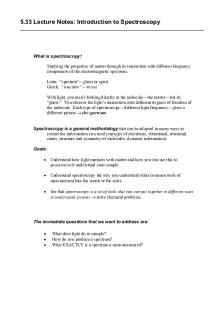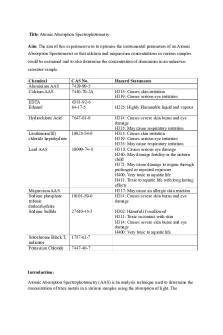Sample Atomization – Atomic Absorption Spectroscopy Learning Module PDF

| Title | Sample Atomization – Atomic Absorption Spectroscopy Learning Module |
|---|---|
| Course | Espectros Atomicos y Moleculares |
| Institution | Universidad Nacional Mayor de San Marcos |
| Pages | 7 |
| File Size | 391.1 KB |
| File Type | |
| Total Downloads | 96 |
| Total Views | 150 |
Summary
Atomic Absorption Spectroscopy...
Description
Atomic Absorption Spectroscopy Learning Module
MENU
Sample Atomization Atomic Absorption Spectroscopy requires the conversion of the sample to gaseous atoms, which absorb radiation. In AAS the sample is most commonly introduced as a solution. The solution is drawn in through a small tube and taken to the nebulizer where the solution is broken up into a ne mist (this is similar to an aerosol can). The ne mist is carried to the atomizer, such as a ame, by a carrier gas. When the mist reaches the ame, the intense heat breaks up the sample into its individual atoms. This nal process is called atomization.
Atomization There are two main types of atomizers: discrete and continuous. Continuous atomizers introduce the analyte in a steady manner whereas discrete atomizers introduce the analyte discontinuously. The most common continuous atomizer in AAS is a ame, and the most common discrete atomizer is the electrothermal atomizer. Sample atomization limits the accuracy, precision, and limit of detection of the analytical instrument. The purpose of the atomization step is to convert the analyte to a reproducible amount of gaseous atoms that appropriately represents the sample.
Electrothermal Atomization
During electrothermal atomization, a sample goes through three phases to achieve atomization. First, the sample is dried at a low temperature. Then the sample is ashed in a graphite furnace (discussed below), followed by a rapid temperature increase within the furnace where the sample becomes a vapor containing atoms from the sample. Absorption is measured above the heated surface where the sample was atomized. A graphite furnace is made up of a graphite tube open at both ends with a hole in the center for sample introduction. The tube is encased within graphite electrical contacts at both ends that serve to heat the sample. A supply of water is used to keep the graphite furnace cool. An external stream of inert gas ows around the tube to prevent outside air from entering the atomization environment. Outside air can consume and destroy the tube. An internal stream of inert gas ows through the tube, carrying away vapors from the sample matrix.
Electrothermal atomizers provide enhanced sensitivity because samples are atomized quickly and have a longer residence time compared to ame AAS systems, which means more of the sample is analyzed at once. This method can also be used for quantitative determinations based on signal peak height and area. Electrothermal atomization also oers the advantage of smaller sample size and reduced spectral interferences because of the high temperature of the graphite furnace. However, electrothermal atomizers have disadvantages including slow measurement time because of the heating and cooling required of the system and a limited analytical range. Additionally, analyte and matrix diuse into the graphite tube, and over time, the tube needs replacing, increasing maintenance and cost associated with electrothermal atomization.
This is because the matrix, even though removed, still plays a role in the scale of detection.
Flame Atomization After being nebulized by gaseous oxidant and mixed with fuel, the sample is carried into a ame where the heat allows atomization to occur. Once the sample reaches the ame, three more steps occur, desolvation, volatilization, and dissociation. First a molecular aerosol is produced when the solvent evaporates (desolvation), then the aerosol is formed into gaseous molecules (volatilization) and nally the molecules dissociate and produces atomic gas (dissociation). During this process cations and electrons can also be formed when the atomic gas is ionized.
Fuels and Oxidants The table shown lists the most common fuels and oxidants used to produce ames for AAS. A mixture of dierent oxidants and fuels can be used to achieve a specic temperature range. Because dissociation and breaking molecules down to atoms is easier with more heat present, oxygen is the most common oxidant used in ame atomization. To control the ow rate of an oxidant and fuel a rotameter is used, this is a vertically placed tapered tube. With the smallest end placed down, a oat which is located inside the tube determines the ow rate. Close control is vital because the ame is very unstable outside of its specic ow rate range. If the ow rate is not greater than the burning velocity indicated, the ame will experience ashback and propagate back to the burner. If the ow rate is too high, the ame will blow o the burner. When the ow rate and burning velocity are equal, the ame is stable. Usually the ame consists of an excess of fuel to prevent oxides forming with the molecules of the sample.
Flame Structure All locations of a ameare not equal in temperature, and are not equal in fuel to oxidant ratio. The three main zones of a ame include the primary combustion zone, secondary combustion zone, and the interzonal region. The interzonal region is prevalent in free atoms and is the hottest area of the ame. It is therefore the region used for spectroscopic analysis. The ame usually rises about 5 cm above the burner tip, with 2.5cm being the max temperature point. The portion of the ame used for AAS is specic as to what element is being analyzed. Due to
the formation of oxides, dierent elements achieve max absorbance at dierent distances (cm) above the burner.
Flame atomic atomization is the most reproducible of all the liquid- sample introductions, however . , and . Samples could be drained as waste and therefore have a low residence time, leading to low eciency. Another disadvantage of ame atomic atomization is the
. Transition metals need more energy than alkali metals to excite their outer electron which is why the higher detection limit is needed
A variety of means are used to create the vapor of atoms from the sample that will be analyzed by the AAS. In addition to the methods previously discussed,
In a general glow-discharge atomization system, the sample is placed on a cathode. Argon gas is ionized by an applied voltage on the cell, causing the argon ions to accelerate to the cathode where they interact with the sample and eject atoms. This process is called sputtering, the ejection of atoms from a sample as a result of bombardment by energetic species. Samples must either have conducting qualities or be mixed with conducting materials like graphite or copper. The sputtered atoms are then introduced to the path of radiation for analysis by a vacuum; this is so outside air will not be analyzed only the analyte of interest will be analyzed. This atomization technique can be used in conjunction with a ame AAS system, and can be used for bulk analysis and depth proling of solids.
A volatile hydride-containing the sample is generated and carried to the atomization chamber by an inert gas. During the atomization process, the sample is freed into atoms by heat, releasing the sample from the hydride compound. This can be done in a ame or furnace environment. ,
.
In this technique, mercury is acidied and reduced and then swept through by a stream of inert gas. Absorption of this gas is then determined.
More on Electrothermalatomization byDr. Scheelineand Dr. Spudich here:http://www.asdlib.org/learningModules/AtomicEmission/solid-introduction.html
maryville.edu 650 Maryville University Drive St. Louis, Missouri 63141 314.529.9466
Home What is AAS? Radiation Sources Sample Introduction Sample Atomization Wavelength Selectors Background Correction Detectors Processing / Display Instruments Safety Uses About Us Contact Us References
© 2020 Maryville University. All rights reserved....
Similar Free PDFs

Atomic Absorption Spectroscopy
- 271 Pages

Atomic Absorption Spectroscopy
- 9 Pages

Atomic Absorption Spectroscopy
- 1 Pages

Chem 1411 Atomic Spectroscopy
- 3 Pages

Spectroscopy
- 5 Pages

Learning- Module Buscor Module 5
- 20 Pages

Mass Spectroscopy
- 14 Pages

Module 2: Learning (Paxton)
- 9 Pages

Learning Module 1
- 4 Pages

cookery g10 learning module
- 402 Pages
Popular Institutions
- Tinajero National High School - Annex
- Politeknik Caltex Riau
- Yokohama City University
- SGT University
- University of Al-Qadisiyah
- Divine Word College of Vigan
- Techniek College Rotterdam
- Universidade de Santiago
- Universiti Teknologi MARA Cawangan Johor Kampus Pasir Gudang
- Poltekkes Kemenkes Yogyakarta
- Baguio City National High School
- Colegio san marcos
- preparatoria uno
- Centro de Bachillerato Tecnológico Industrial y de Servicios No. 107
- Dalian Maritime University
- Quang Trung Secondary School
- Colegio Tecnológico en Informática
- Corporación Regional de Educación Superior
- Grupo CEDVA
- Dar Al Uloom University
- Centro de Estudios Preuniversitarios de la Universidad Nacional de Ingeniería
- 上智大学
- Aakash International School, Nuna Majara
- San Felipe Neri Catholic School
- Kang Chiao International School - New Taipei City
- Misamis Occidental National High School
- Institución Educativa Escuela Normal Juan Ladrilleros
- Kolehiyo ng Pantukan
- Batanes State College
- Instituto Continental
- Sekolah Menengah Kejuruan Kesehatan Kaltara (Tarakan)
- Colegio de La Inmaculada Concepcion - Cebu





